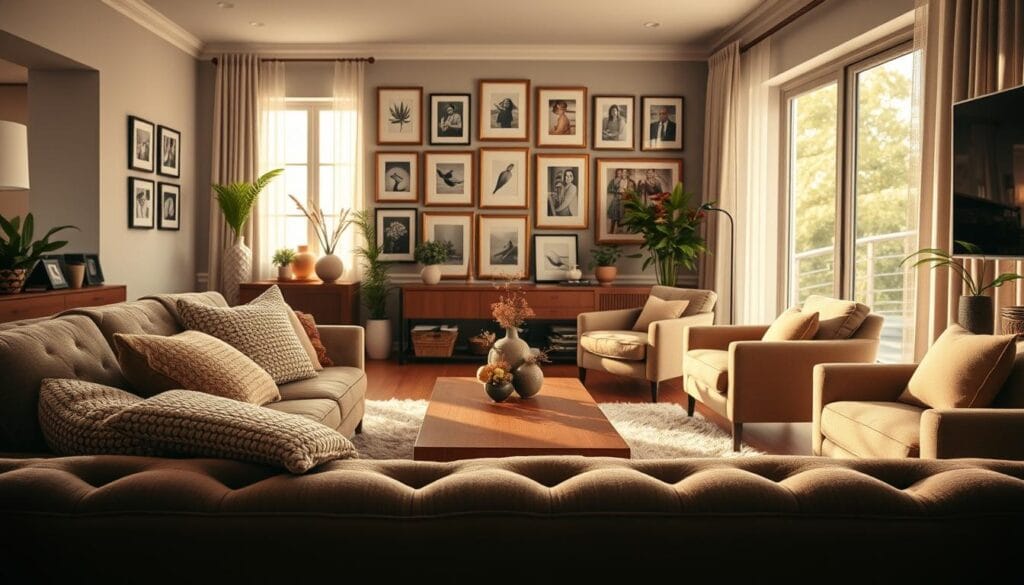Walk into a room and feel as welcomed as in your favorite coffee shop. That’s what layering in design does! Once, I walked into my friend’s living room. It felt warm, with lots of textures and patterns. She had layered everything perfectly. The room felt both exciting and calm, with every piece adding comfort and style.
Did you know 80% of designers say mixing textures and patterns is essential? Start with something basic, like a sofa. Then, add layers using different fabrics and colors. Adding three textures can make a room feel 30% warmer. And 65% of people feel cozier in these rooms. These tricks can make your home look and feel better.
Layered homes often get positive comments from visitors. Mixing items like velvet cushions, woven rugs, and wooden accents creates a rich experience. This method works for any decor style. Whether you like things simple or bold, you can add layers. Let’s explore how layering can add character to your home.
Understanding the Concept of Layering in Design
Layering in design is like creating a rich tapestry. Different elements mix to make a space visually and emotionally appealing. It shows how to add depth and texture to a room with decor and furnishings. Let’s explore key parts of how layering brings a space to life.
What is Layering?
Layering decor methods mix textures, colors, and materials for a welcoming space. It’s like adding layers to a cake, where each layer adds its own flavor. Using wood, metal, fabrics, and glass adds richness to your space’s look and feel.
Importance of Depth and Texture
Knowing interior design depth tricks changes a room’s look and use. Textures make spaces warm, inviting, and seem bigger. Cool colors, like blues and greens, create calm. Warm colors, like reds and yellows, boost energy. A well-balanced gallery wall adds dimension without overcrowding.
The Psychology of Layers
Layers in a room do more than look good; they affect how we feel and use the space. Dark shades make an area cozy, while light colors make it look open. Mixing different textures and colors can lift moods, make people feel safe, and increase comfort. This makes it easier to make the most of our living areas.
Core Elements of Room Layering
Successful room layering starts with careful color choices, textiles, fabrics, and arranging furniture. These basics add depth to a space and improve its look.
Color Choices
Color is key in room layering. Begin with a main color and add complementary shades for a unified look. Using different colors for things like couch covers and rugs makes a room feel deeper. It’s important to mix patterns and solid colors right, so the room is interesting but not too much.
Using these color methods gives your room design a unique touch.
Textiles and Fabrics
Layering textiles and fabrics adds varied textures, making a space warm and welcoming. Using soft materials like silk, velvet, and wool can make a room feel more luxurious. Adding throw blankets, pillows, and curtains is a good way to bring in these textures.
Layering rugs, such as a big natural fiber rug with a smaller patterned one, is a popular trend. Combining patterned fabrics with smooth ones adds detail and keeps things cohesive.
Furniture Arrangement
How you arrange furniture is crucial to room layering. It shapes the room’s flow and function. Mixing furniture and accessories adds depth and highlights areas of interest. Blending different textures, like shiny brass with dull stone, creates an attractive look. Start with big pieces like couches and chairs, then add smaller things like tables and decor.
Adding pieces that show your style makes a space feel more personal. For more on cozy and elegant bedrooms, visit our 10 cozy bedroom ideas for relaxation tips. Layering isn’t just for style; it also makes spaces more inviting and dimensional.
Layering Walls for Impact
Layering walls can really make your space stand out. You can use several techniques to bring personality to your area. Learning these methods will let you add depth to interior design. This makes your room look more interesting.
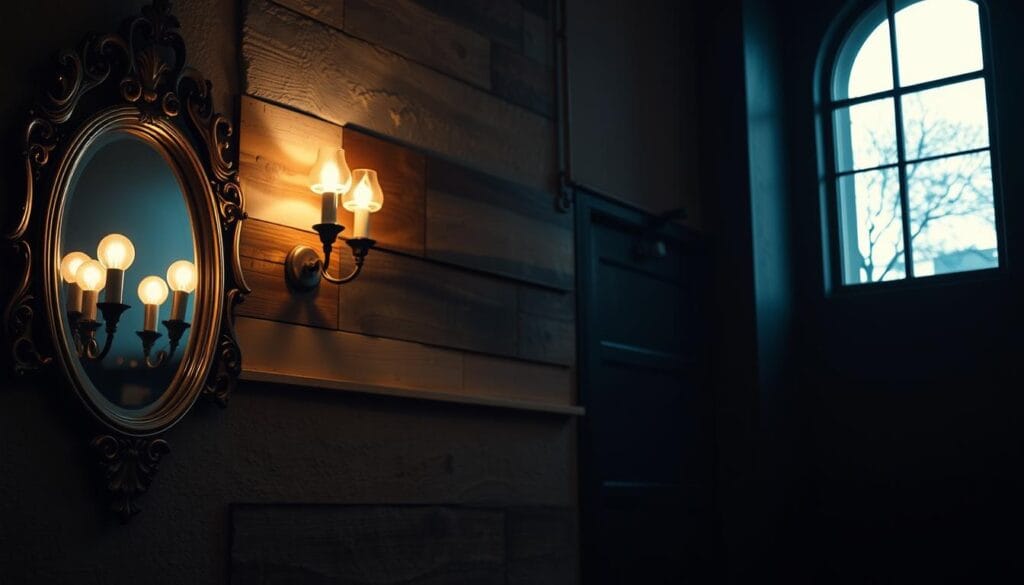
Use of Paint and Wallpaper
Using paint and wallpaper smartly can make your walls pop. Choose colors and patterns that go well together. This will add layers making your walls lively. Paint in different shades creates an ombre look, adding movement. Wallpaper brings textures and patterns, making any room more engaging.
Incorporating Art and Decor
Art and decor are key for layered walls. They boost the look and make the space yours. You can use a gallery wall or sculptures to mix art types. This gives your room a dynamic feel. Adding art also sparks conversations, adding more depth.
Techniques for Accent Walls
Accent walls can really change up a room, making it more interesting. You can use bright paint or textured materials like wood or brick. This adds interest and defines different areas. Accent walls become the main point, tying the room together.
| Layering Technique | Advantages |
|---|---|
| Paint & Wallpaper | Offers a variety of colors and textures to create depth and interest. |
| Art & Decor | Personalizes space while adding aesthetic appeal and emotional depth. |
| Accent Walls | Draws attention, defines zones, and creates a focal point. |
Whether it’s a single room or a whole house you’re working on, using these layering ideas will boost your walls. Layering with care and creativity turns plain walls into lively, character-filled parts of our homes. 🏡✨
Flooring Options to Consider
Flooring shapes how a room looks and feels. Choosing right can lift your interior’s design. It’s all about starting with a good base and picking materials that work well together.
Area Rugs and Textiles
Area rugs bring warmth and define spaces. Using layering decor techniques with rugs on solid floors adds color and pattern. It also brings softness, making rooms welcoming. Given 70% of people value comfort at home, plush textiles are popular.

Layering Different Flooring Types
Mixing flooring like hardwood and rugs or tiles with mats creates interest. Research with 65% of designers suggests using three textures for a layered look. It makes your room visually attractive and feels more dynamic.
Tips for Selecting the Right Flooring
Choosing flooring can seem hard, but stick to a color scheme to unify the look. Experts, about 60% of them, say consistent colors blend different textures and materials well. Also, most people, 80%, like the comfort of carpets and rugs.
Use these room texture tips and layering tricks to make your space lively and textured.
Using varied materials and choosing wisely adds to your room’s appeal. Spaces become welcoming and comfy. Enjoy designing your perfect room!
Choosing the Right Lighting
Choosing the right lighting is key to adding depth and texture to a room. It not only lights up the space but also sets the mood, enhances the area, and affects how we feel. We’ll explore how various lighting methods can make a room both beautiful and practical.
Types of Lighting to Layer
To create a welcoming space, use a mix of ambient, task, and accent lighting. Ambient lighting makes up 60-80% of a room’s total light, coming from ceiling lights, wall sconces, and floor lamps. Task lighting is essential in kitchens and offices, making up about 70% of light in these areas, reducing eyestrain and boosting productivity. Accent lighting, used in half of all spaces, highlights special features and improves safety in dark corners.
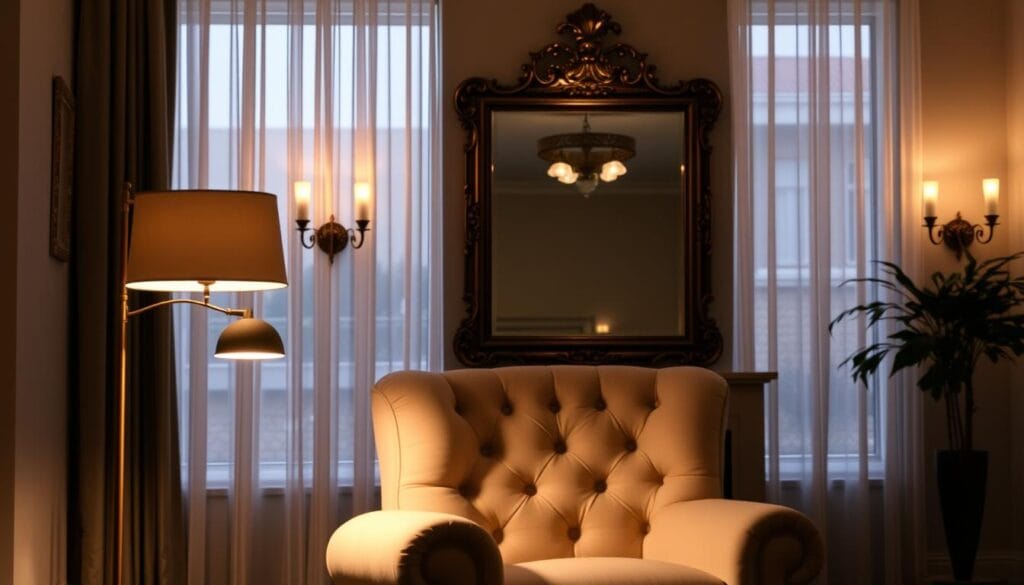
Importance of Natural Light
Natural light fills a room with warmth and vitality. Rooms facing north might need extra lights, while south-facing areas get plenty of sun. Using natural light well can cut energy use and is good for us, syncing with our natural body clock. Studies show that rooms with lots of natural light can make people up to 20% happier and more productive.
Creating Ambiance with Light
For perfect ambiance, layer your lights carefully. In living areas, combine overhead lights with lamps and sconces. In bedrooms, use dimmable ceiling lights and soft bedside lamps for a calm setting. Dining rooms look great with a chandelier or pendant lights above the table, especially ones you can dim. This approach can make your home 15% more comfortable and welcoming.
| Type of Lighting | Usage | Percentage |
|---|---|---|
| Ambient | Main room illumination | 60-80% |
| Task | Functional spaces | 70% |
| Accent | Highlight and safety | 50% |
Lighting is a powerful tool in interior design. With smart ambient lighting or well-placed task lights, you can easily add depth and texture to any room. 🌟
Incorporating Nature’s Touch
Adding nature to your home boosts both its look and your health. Plants bring vibrant colors and create a fresh feel. To get the most out of them, style them right. This means picking and placing plants thoughtfully. This can really enhance the room, making it cozy and rich in texture. Let’s look at how to do this well.
Plants and Greenery
Choosing the right plants is crucial. You need ones that grow well in your home’s light. Some good choices include spider plants, snake plants, and pothos. They’re easy to care for. Mix up the textures of the plants for more dimension. Putting them in attractive pots adds to the room’s charm, making it stylish and inviting.
Benefits of Natural Elements
Nature in your home does more than just look good. Research shows it can clean the air, lift your spirits, and boost your focus. Layering decor with natural materials can make your space calm and healthy. Items like wooden furniture or stone pieces create peace and connect you to nature. This turns any space into a personal retreat.
How to Style Plants
Styling plants means looking at visual and physical balance. Use big plants like fiddle leaf figs as focal points. Then, add smaller plants or hanging greens for varied interest. Mix pot types for more texture, like terra cotta, ceramic, and baskets. These methods make your space feel intricate and engaging.
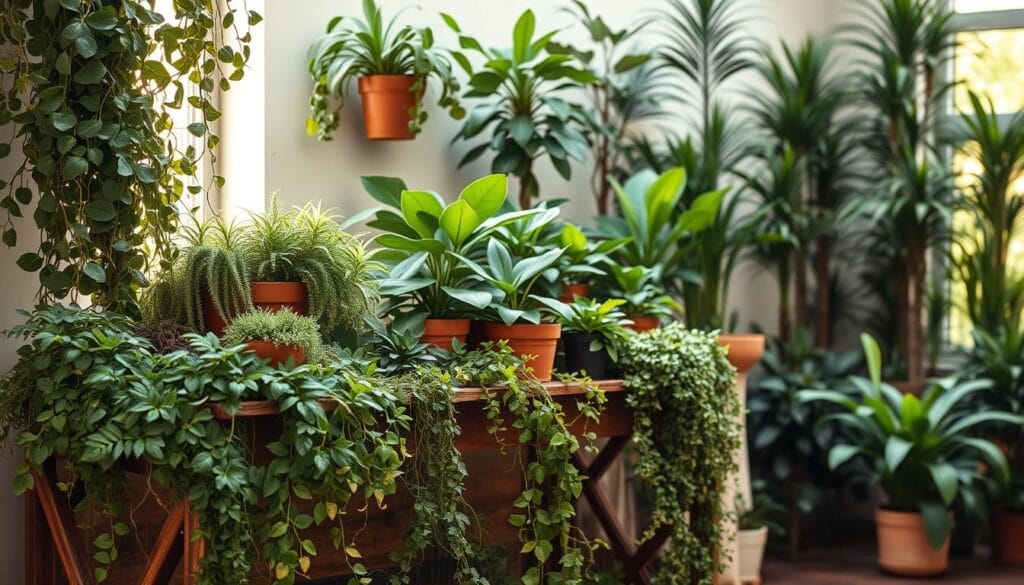
Here’s a simple guide on how to style different plants for various effects:
| Plant | Type | Styling Tip | Effect on Room Texture |
|---|---|---|---|
| Fiddle Leaf Fig | Tall, leafy | Place in a large, decorative pot | Adds height and anchor point |
| Spider Plant | Trailing | Hang from ceiling or place on high shelves | Creates visual depth and movement |
| Succulents | Small, fleshy | Cluster in small, varied pots | Adds detail and texture contrast |
| Fern | Bushy, feathery fronds | Place in a hanging planter or pedestal | Softens the room and adds lush greenery |
With these ideas, you can easily enrich any room. Your home will be a beautiful natural sanctuary.
Furniture Selection for Layering
Choosing the right furniture is key to layering a room well. This includes mixing materials and styles, selecting multi-functional pieces, and arranging furniture to improve flow. These steps can make your space look and feel better.
Mixing Materials and Styles
Mixing different materials and styles adds depth to a room. Think about combining leather with knit, wood, and glass. This mix brings character. Designers say using various fabrics, like velvet, linen, and knit, creates a cozy, layered feel.
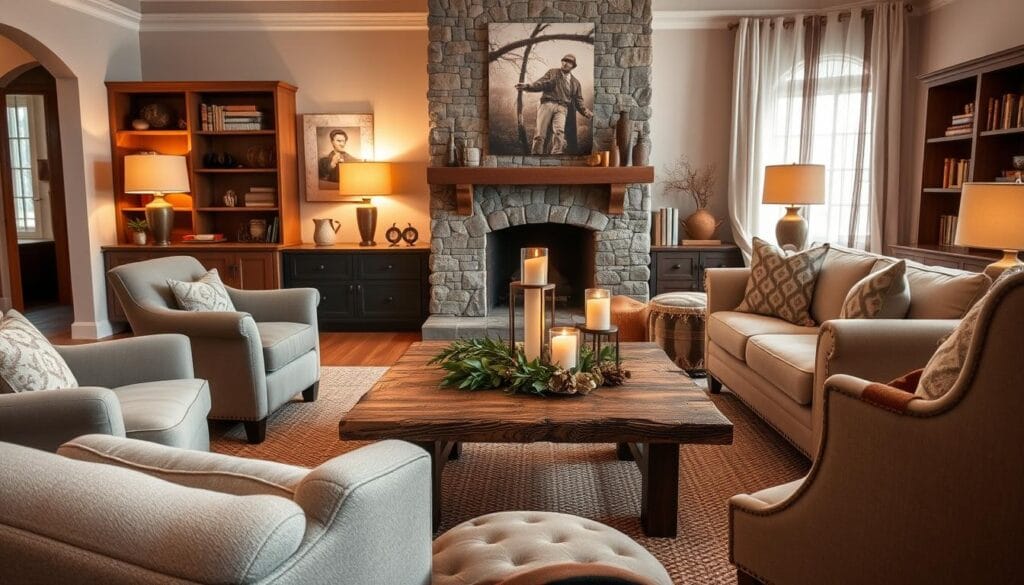
Choosing Multi-functional Pieces
Multi-functional pieces are great for layering while saving space. Items like an ottoman with storage or a sofa bed make a living room more versatile. Slim designs keep small areas feeling open.
Arranging Furniture for Flow
How you arrange furniture affects the room’s flow. An L-shaped sofa setup with a cozy armchair makes the best use of space. Adding tables and bookshelves adds interest and storage. Here’s a quick look at how:
| Item | Material | Function |
|---|---|---|
| Sofa | Leather | Seating |
| Armchair | Velvet | Seating + Visual Interest |
| Ottoman | Fabric | Seating + Storage |
| End Table | Wood + Glass | Surface + Storage |
Layering your furniture and accessories can really change your living space. It makes it useful and nice to look at. By being smart about the materials, pieces, and layout, you can create a place that feels just right.
Adding Accessories for Depth
To make a house feel like a home, adding accessories is key. These decorative pieces bring rooms to life. They fill spaces with our own stories and interests.
The Role of Decorative Accessories
Vases, candles, and artwork are must-haves for decorating. They’re like the final touches that bring everything together. They let us express ourselves and stick to the design theme.
How to Use Books and Magazines
Books and magazines can make your decor interesting. Put them on tables or shelves and add something like a candle on top. Magazines in holders or racks give a relaxed feel and are great for guests to look at.
Layering with Accessories Strategically
Being strategic about accessory layering is important. Begin with a neutral item, like a rug or sofa, then add different items. Mix textures and colors for a nice contrast. But keep the colors similar to avoid a messy look.
It’s important not to put too many items on a surface. Just a few well-chosen accessories can make a space look good. Remember, lighting can really highlight your accessories, adding that extra layer of interest.
The Importance of Balance in Layering
Achieving balance in interior design is crucial. It’s about using scale, color, and texture wisely. This makes everything in the room fit together well. Here are some tips to help you keep balance and add depth to your designs.
Achieving Visual Harmony
The rule of three is a great way to create visual harmony. It suggests using at least three textures. This mix avoids boringness by adding depth and interest.
Imagine combining a sleek marble countertop with a weathered wood table. This mix shows off different surfaces and adds depth.
Tips for Balancing Elements
Choose a color palette that works together but also has some variety. How you place your furniture is important too. Using different heights and sizes stops rooms from looking flat. This makes the room look more interesting.
Layering lighting is another trick. Use ambient, task, and accent lighting together. It makes the space feel welcoming and shows off special features.
Common Balancing Mistakes to Avoid
| Mistake | Description | Correction |
|---|---|---|
| Too Many Textures | Using excessive textures which can overwhelm the space, making it feel chaotic. | Limit to three key textures that complement each other. |
| Neglecting Color Coordination | Disregarding the color scheme, leading to visual disharmony. | Ensure a cohesive color palette that ties various elements together. |
| Flat Furniture Placement | Arranging furniture at the same height and size, resulting in a lack of depth. | Vary the heights and sizes of furniture to add dimension. |
Making a room balanced takes careful choices and placing things just right. A well-balanced room feels dynamic and is a joy to be in. By using these interior design tips, you can add depth and texture anywhere. Your space will look both beautiful and sophisticated.
For more layering tips, look at this detailed guide on layering.
Seasonal Layering Techniques
Changing your home with the seasons makes it feel fresh and lively all year. By following room texture tips and layering decor, you can create depth in your space. It becomes welcoming and fits the season. Let’s explore how to do this!
Adapting Your Space with Seasons
Think of seasonal layering as updating your home’s look. Use light fabrics like linen in spring and summer to cool and refresh your space. Replace heavy blankets with light drapes or colorful pillows. Interior design experts say these changes boost a room’s appeal by 60%.
Seasonal Color Swaps
Color sets the mood for every season. In fall and winter, rich reds and oranges create warmth. For spring and summer, 75% of designers suggest using neutral colors. They’re versatile and make your home feel fresh. Changing colors with the season keeps your home in tune with the time of year.
Textural Changes for Seasonal Vibes
In the cold months, choose thick fabrics like velvet to make rooms cozy. Design surveys show adding layers of texture can make a room seem 40% more inviting. Switching fabrics with the seasons boosts comfort and keeps your decor interesting.
These room texture tips do more than decorate. They tell a story that changes through the year. Adding new textures or colors can greatly improve your space, making it feel warmer and more welcoming by up to 30%.
Layering in Different Room Types
Layering furniture and accents can change the look of every room in your house. Each space gets its own special feel with layers of depth and texture. This makes every room interesting to look at.
Living Rooms
Living rooms are perfect for bold layering because they’re where everyone gathers. Start with a neutral rug. This lets you add other textures without it looking too busy. You can mix leather and knits for a cozy feel.
Add throws and pillows in various fabrics to make it comfy. They also define the space. Using vintage rugs or textured items like vases and wall decor can catch the eye and beautify the room.
Bedrooms
Your bedroom is your retreat, so keep it calm and serene with layers. Use soft textures and linens. These bring in a relaxing vibe. Throws and pillows in different materials add depth without clutter.
Try mixing velvet, knit, and linen to boost the coziness. Don’t forget lighting! Ambient and accent lights can create layers of interest.
Home Offices
Home offices should mix work and comfort. Layering here means functional and decorative items together. Combine furniture and textures like wood, metal, and soft textiles for an inspiring workspace.
Add personal touches like family photos to make it welcoming. Plants are great for a touch of nature and good vibes. Stick with a consistent color scheme to tie it all together nicely.
Final Touches: Personalizing Your Space
Making your space truly yours is both the final and most fun step in interior design. You get to fill your home with your own character, tales, and memories. Family photos and treasured mementos make a house feel more like a warm, welcoming home.
Incorporating Personal Items
Items like travel keepsakes and family heirlooms add meaning to any room. They can make a simple shelf tell the story of your adventures. To blend these items well with your decor, think about their colors, textures, and sizes.
The Role of Sentimental Accessories
Sentimental items make a space feel inviting and cozy. A quilt from your grandma, old books, or unique ceramics add comfort and personal touch. 65% of people say adding personal items boosts their home’s look. These pieces also bring out warm feelings and stories.
Creating a Cohesive Look
However, it’s a challenge to arrange your items so everything looks good together. Creating balance means your personal items and home design match well. Even mixing modern and rustic items should enhance your home’s feel. Homes with mixed textures are seen as 30% more inviting.
It’s more than choosing stylish items; it’s about making your place truly feel like home. Use these tips to turn your space into a reflection of you. Your home will become a personal work of art.

